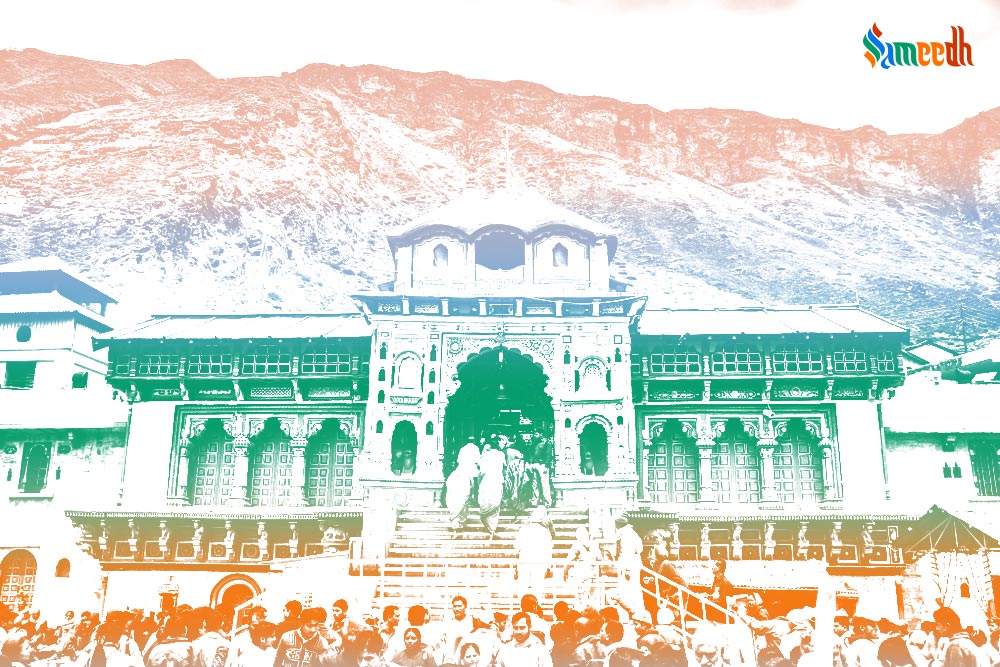Badrinath temple is a prominent temple of Bhagwan Vishnu located in Uttarakhand, India.

The Badrinath Temple, also called the Badrinarayan Temple, is situated in the town of Badrinath. It is located in the Garhwal region of the Himalayas on the bank of Alaknanda River, nestled between the Nar-Narayan mountain peaks. Adi Shankaracharya is thought to have founded the temple in the eighth century. Bhagwan Vishnu is the principal deity of the Badrinath temple.
Location and Historical significance
Divinity and serenity come together in the charming town of Badrinath. One of the sacred temples of Char Dham is a prominent temple of Bhagwan Vishnu, which is situated at a height of around 3,100 metres in Uttarakhand’s Chamoli district. Rameswaram, Puri, and Dwarka are other Char Dham destinations. The temple situated between the Nar and Narayan peaks, is a part of the Chota Char Dham, comprising Yamunotri, Gangotri, Kedarnath and Badrinath. It is the culminating and most renowned destination of the Garhwal region of the Himalaya.
Motorable roads make it easier to travel to Badrinath town, and a brief hike will get you to the Badrinath temple. The Mana village is the last village before the border between India and Tibet. It is located about 3 km from Badrinath. One of the most fabled Temples, Badrinath is associated with a lot of tales. According to one story, Bhagwan Vishnu had performed an exhaustive meditation here. He was deeply focused in his meditation and had no idea of the inclement weather. His wife Mata Lakshmi took the form of a Badri tree and covered over him to shield him from the sweltering sun. When Bhagwan Vishnu saw this, he was touched by her love and named the place as ‘Badrikashram’, in her honour.
According to another popular account, Bhagwan Shiv and Mata Parvati used to do tapasya in Badrinat Bhagwan Vishnu interrupted them by wailing aloud, disguised as a small childWhen Mata Parvati questioned him about his gloomy mood, to which He responded that He wanted to meditate at Badrinath. When Bhagwan Shiv and Mata Parvati learned that Bhagwan Narayan was under a disguise, they left Badrinath and went to Kedarnath.
Adi Shankaracharya placed the Shaligram idol of Bhagwan Badri in a cave close to Tapt Kund. He had found the Shaligram submerged in the Alaknanda River. Years later, a king of Garhwal had ordered the construction of the temple around the 16th century, to accommodate the deity. The temple has endured numerous restorations as a result of avalanche and earthquake damage, resulting in the present structure. A black stone sculpture of Bhagwan Vishnu in a meditative posture can be seen worshipped with idols of other deities such as Nar-Narayan, Garud, Bhagwan Ganesh, Kuber and Narad. During winters, the idol of Bhagwan Badri is taken to Yogdhyan Badri near Pandukeshwar in the Chamoli district of Uttarakhand.
The Architecture
The Badrinath Temple is built in the classic North Indian architectural style. The temple’s walls and pillars are made of stone, and it has numerous carvings on it. A tall archway at the entry leads to Sabha Mandap that connects Darshan Mandap and then to Garbhagrih. The Garbh Griha’s roof rises 15 metres with a dome at the top. With a conch and a chakra in each arm, the majestic Badrinarayan deity standing one metre tall in black stone rules the inner sanctuary. Bhagwan Vishnu is meditation in the Padmasana position with His other two arms on his lap. Mata Lakshmi is seated beside Him. The temple gets its ultimate form with Maa Durga, Rishi Narad, Kuber, Nar-Naryan, Uddhav on either side of the deity.
Festivals and rituals at Badrinath temple
The most significant celebration at Badrinath Temple, Mata Murti Ka Mela, honours the Ganga River’s arrival upon the Earth. In June, both Kedarnath and Badrinath temples celebrate the Badri Kedar festival. Eight days of the festival are dedicated to performances by musicians from throughout the world. During the rites, verses from Vedic texts like the Ashtotram and the Vishnu Sahasranama are recited. Every year, from Vijayadashami until November, the temple closes for the winter. Within the temple, a six-month-long ghee lamp called the Akhand Jyoti is lit. The temple is reopened on the day of Vasant Panchami in April after a six-month hiatus. On this day, a large crowd gathers at the temple to witness the Akhand Jyoti.
